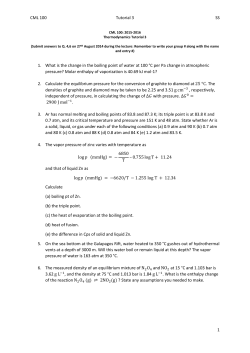
atmospheric pressure
Chapter 9 Fluid Mechanics 9-2 Fluid Pressure and Temperature Pressure – a measure of how much force is applied over a given area. Formula: P = F/A Pressure = Force (N) / area (m2) Fluids – ability to flow – gases and liquids • Our atmosphere – “ocean of gas” • Density of our atmosphere decreases with altitude • The atmosphere exerts pressure – atmospheric pressure – caused by the weight (in Newtons) of the air. Barometer Measures atmospheric pressure or “barometric pressure” The SI unit for measuring Pressure = pascal (Pa) = 1 N/m2 1 square meter at sea level = 100,000 N -- so 100,000 N/m2 Average atmospheric pressure at sea level is 101.3kPa Or 1000000 Pa Conversions: All equivalent units 14.7 pounds per square inch (psi) = 29.92 in Hg = 760 mm Hg = 101.3 kPa = 1.00 atm Example: Convert 232 psi to kPa 232 p.s.i ● 101.3 kPa 14.7 psi = 1599 kPa Example: Convert 3.50 atm to mm Hg 3.50 atm ● 760 mm Hg 1 atm = 2660 mm Hg 9-4 Properties of Gases Ideal gas Law – relates gas volume, pressure and temperature. For a given Volume of Gas at a given Pressure and a given Temperature there should be a consistent # of molecules/atoms, n Formula: P ● V = n ●R ● T n = number of moles R = universal gas constant = 8.31 J / (mol ● K) K = SI unit of temperature Kelvin (0C + 273) Avogadro: said that it doesn’t matter what gas it is, 1 mole = 22.4 L of gas (6.02 x 1023 particles) at STP (standard temp/press) = 00C and 1 atm of pressure Example: How many moles of carbon dioxide gas (CO2) are contained in a 6.2 L tank at 101 kPa and 30 0C? Given: V = 6.2 L P = 101 kPa T = 30 oC (303 K) And, Constant R = 8.31 kPa x L / mol x K) n=? Ideal Gas Law -- n = 0.25 mol P ●V= n●R ●T Boyles’ Law: The pressure and volume of a gas at constant temperature are inversely proportional. Increase one – decrease the other. • Increasing pressure on a gas (compressible) decreases volume. Formula: P1 ● V1 = P2 ● V2 Boyles’ Law: A graph of an inverse relationship P1 ● V1 = P2 ● V2 Example: A volume of gas at 1.10 atm was measured at 326 cm3. What will be the volume if the pressure is adjusted to 1.90 atm? Given: P1 = 1.10 atm, V 1 = 326 cm3, V2 = ? , P2 = 1.90 atm Answer V2 = 189 cm3 Charles’s Law: at constant pressure, the volume of a gas is directly proportional to its Kelvin temperature Increase one, increase the other. Formula: V1T2 = V2T1 proportional to its Kelvin temperature or V1 = T1 V2 T2 Direct relationship Example: The gas in a balloon occupies 2.25 L at 298 K. At what temperature will the balloon expand to 3.50 L? Given: V1 = 2.25 L T1 = 298 K T2 = ? V2= 3.50 L T2 = 464 K “Combined Gas Law” P1V1 = P2 V2 T1 T2 Always convert temperature to Kelvin. Gay-Lussac’s Law: •The pressure of a gas is directly proportional to the Kelvin temperature if the volume is held constant. Direct relationship P1 / T1 = P2 / T2 Question: The air temperature at an altitude of 10 km is a chilling ---35 0C. Cabin temperatures in airplanes flying at this altitude are comfortable because of air conditioners rather than heaters. Why? Answer: Airliners have pressurized cabins. The process of stopping and compressing outside air to near sea-level pressures would normally heat the air to a roasting 55 0C (130 0F). So air conditioners must be used to extract heat from the pressurized air.
© Copyright 2025





















